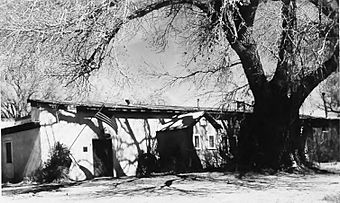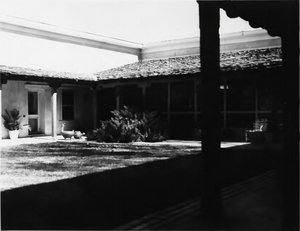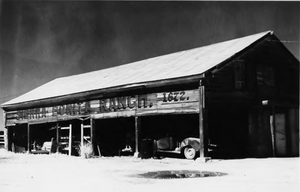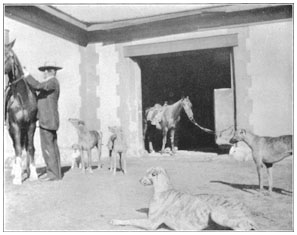Sierra Bonita Ranch facts for kids
|
Sierra Bonita Ranch
|
|

Sierra Bonita Ranch house, 1975
|
|
| Location | Graham County, Arizona, USA |
|---|---|
| Nearest city | Willcox, Arizona |
| Built | 1872 |
| Architectural style | Spanish Colonial |
| NRHP reference No. | 66000181 |
Quick facts for kids Significant dates |
|
| Added to NRHP | October 15, 1966 |
| Designated NHL | July 19, 1964 |
The Sierra Bonita Ranch is a very old cattle ranch in the United States. It was started in 1872 by Henry C. Hooker. The buildings at the ranch are so important that they have been named a National Historic Landmark. This means they are special places that tell a big part of American history.
This ranch was the first lasting American cattle ranch in Arizona. Henry Hooker bought more and more land until his ranch became the biggest in Arizona. It covered about 800 square miles (2,072 square kilometers). That's like a square about 27 miles (43 km) on each side! The ranch is located in the Sulphur Springs Valley, about 27 miles (43 km) north of a town called Willcox, Arizona. Today, the ranch is smaller, but it still works and is owned by Jesse Hooker Davis. He is the sixth generation of the Hooker family to live and work there.
Contents
Starting the Ranch
Long ago, before Spanish people arrived, the Chiricahua Apache people visited and might have lived in the valley. Around 1775, the Mexican government tried to make peace with the Native American groups. This helped reduce fighting. By the early 1800s, many Mexican ranchers lived in the area. They had thousands of cattle roaming freely.
However, after the Mexican War of Independence, settlers in the northern areas lost government protection. Apaches stole or killed most of the cattle. Many settlers went back to Mexico, and some were killed. By 1840, only old ruins and a few wild cattle herds showed that people had been there before.
The Gold Rush and Cattle Prices
The California Gold Rush began in 1849. Many people traveled through the valley to get to California. But at this time, only the Apache people lived there. Before the Gold Rush, cattle were mostly used for their hides (skins) and tallow (fat). A grown steer (a male cow) was worth only about $4.00.
The Gold Rush brought many miners and merchants to California. This caused a huge demand for beef. The price of cattle went up a lot, sometimes to $75 a head! Ranchers could make money by moving cattle from far away places like Oklahoma, Texas, New Mexico, and Arizona to California. Even though the Chiricahua Apaches sometimes took cattle, it was still profitable. Ranchers would drive the cattle up California's Central Valley. They would then rent land to let the cattle get fat before selling them for a good profit.
Henry Hooker's Arrival
Henry Hooker came to Arizona from California in 1867. He teamed up with Captain Hugh Hinds, whom he knew from Placerville. Hinds had a contract to provide beef to U.S. military bases and Native American agencies in Arizona. Hooker visited each place to find out how much beef they needed. After that, Hooker made another deal with other cattlemen, William B. Hooper and James M. Barney.
A family story says that a group of cattle ran away. Hooker's cowboys found them in what is now called Sulphur Springs Valley. Hooker liked the valley and decided to start his ranch there.
Ranch Buildings and Security
Hooker built his ranch in 1872. It was on the site of an old Spanish hacienda (a large estate) that the Apache had destroyed years before. His main ranch house was a big, U-shaped building. It was about 80 feet (24 meters) by 100 feet (30 meters) and had a central courtyard. The walls were made of two rows of adobe bricks. These bricks were 20 inches (51 cm) thick and the walls were 16 feet (4.9 meters) high.
To keep everyone safe, the outside walls of the building had no doors or windows. The only way in was through a single gate in one wall. Later, another door was added when the area became safer. The courtyard originally had a well and a root cellar for food storage. This helped the ranch be self-sufficient. The roof also had small openings called gunports for defense. Hooker developed a good relationship with the Apache people. They used a trail near his ranch, and he rarely had problems with them.
Growing the Ranch and Livestock
By 1885, Hooker had bought other ranches nearby. He grew his herds and brought in expensive bulls and special cows. He also had dairy cows to provide milk and butter for the ranch. He planted 1,000 acres (405 hectares) of alfalfa and timothy grass. He also grew corn and artichokes to feed many well-bred hogs. He built hen houses for chickens and eggs. He bought six purebred male horses and had over 500 female horses. These horses became famous for their speed, beauty, and good nature.
The ranch eventually included land in Graham and Cochise Counties. It became the largest ranch in Arizona, covering 800 square miles (2,072 square kilometers). Hooker cared a lot about having good animals. In the 1880s, he improved his cattle by bringing in Hereford cows. He was known for raising some of the best cattle, horses, sheep, and dogs in the country.
Hooker built other buildings that are still there today. This includes the original barn, made of adobe and wood. In 1972, the words "Sierra Bonita Ranch 1872" were painted on it to celebrate the ranch's 100th birthday. North of the main house is an old adobe bunkhouse with a tin roof. There is also a large adobe corral for storing hay. Some of the older buildings are not usable anymore. Because the ranch is a National Historic Landmark, it's hard to rebuild them.
Ranch Social Life
The ranch became a popular place for social gatherings in the southeastern Arizona Territory. Hooker welcomed many important people. These included politicians, government and military leaders, artists, writers, and scientists. When guests were invited to dinner, everyone had to wear a coat. Hooker even kept extra coats for guests who didn't have one. Hooker always dressed like a gentleman from the East. He never wore cowboy clothes, even when he was out on the range. A famous writer named Augustus Thomas set his play Arizona at the ranch. He based two of the main characters on Hooker's family.
Geography and Water Supply
The valley where the ranch is located is about 4,000 feet (1,219 meters) high. This elevation helps the ranch avoid extreme heat or cold. It was a perfect place for raising animals. The ranch had plenty of water supply. There were five springs and creeks that flowed in the spring and fall. Also, there was a lot of shallow groundwater that could be reached easily with wells. If there was a drought, Hooker had ditches dug to bring water from the mountains to reservoirs on his ranch. Having a good water source helped Hooker control a large area, about 30 miles (48 km) long and 30 miles (48 km) wide.
Cattle Operations
Hooker became the biggest supplier of beef to the military in the Arizona Territory. At first, Hooker lost many workers and supplies because of Apache raids. He started his ranch with Texas Longhorns and low-grade Mexican cattle. Later, he replaced them with Durham cattle. In the 1880s, he made his herds even better by bringing in Hereford cattle.
He slowly grew his land until he controlled 250,000 acres (1,012 square kilometers). This land held 20,000 cattle. In the Arizona Territory, between 1873 and 1891, cattle herds grew from 40,000 to 1.5 million! Hooker built a strong ranch. He was one of the few Arizona ranchers to survive a terrible drought in 1891. This drought killed more than half the cattle, partly because there were too many animals eating the grass. Efforts to fix the rangeland between 1905 and 1934 had some success. Ranching continued, but on a smaller scale. When Henry Hooker died in 1907, he was still known as the "cattle king" of Arizona.
The Ranch Today
The Sierra Bonita Ranch was named a National Historic Landmark in 1964. It is one of the oldest ranches still operating in the United States.
It is still a working cattle ranch today. As of 2012, it is owned by Jesse Hooker Davis. He is Henry Hooker's great-great-great-grandson. He took over running the ranch from his grandmother, Jacqueline Hooker Hughes. The ranch now covers about 45,000 acres (182 square kilometers). This is about one-fifth the size it was when Henry Hooker started it. Some land was lost to homesteaders (people who settled on land) in the early 1900s. Other parts were given to other family members. The ranch now has only two of the original five wells. It also no longer includes any of the mountain ranges and their water sources.
The adobe ranch house has been updated inside. But it still looks like a strong fortress from the old days. Big cottonwood trees shade it. It is surrounded by the original adobe corrals, bunkhouses, and barns. The ranch is very special for three reasons: it has been used continuously by the same family, the buildings look much like they did long ago, and it has the same setting that first attracted Henry Hooker. The ranch is not open to the public.
Images for kids












